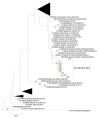Multifacility Outbreak of Middle East Respiratory Syndrome in Taif, Saudi Arabia
- PMID: 26692003
- PMCID: PMC4696715
- DOI: 10.3201/eid2201.151370
Multifacility Outbreak of Middle East Respiratory Syndrome in Taif, Saudi Arabia
Abstract
Middle East respiratory syndrome (MERS) coronavirus (MERS-CoV) is a novel respiratory pathogen first reported in 2012. During September 2014-January 2015, an outbreak of 38 cases of MERS was reported from 4 healthcare facilities in Taif, Saudi Arabia; 21 of the 38 case-patients died. Clinical and public health records showed that 13 patients were healthcare personnel (HCP). Fifteen patients, including 4 HCP, were associated with 1 dialysis unit. Three additional HCP in this dialysis unit had serologic evidence of MERS-CoV infection. Viral RNA was amplified from acute-phase serum specimens of 15 patients, and full spike gene-coding sequencing was obtained from 10 patients who formed a discrete cluster; sequences from specimens of 9 patients were closely related. Similar gene sequences among patients unlinked by time or location suggest unrecognized viral transmission. Circulation persisted in multiple healthcare settings over an extended period, underscoring the importance of strengthening MERS-CoV surveillance and infection-control practices.
Keywords: MERS; MERS-CoV; Middle East respiratory syndrome; Saudi Arabia; coronavirus; epidemiology; genetic sequencing; respiratory infections; serum; viruses.
Figures


Similar articles
-
Scope and extent of healthcare-associated Middle East respiratory syndrome coronavirus transmission during two contemporaneous outbreaks in Riyadh, Saudi Arabia, 2017.Infect Control Hosp Epidemiol. 2019 Jan;40(1):79-88. doi: 10.1017/ice.2018.290. Infect Control Hosp Epidemiol. 2019. PMID: 30595141 Free PMC article.
-
Nosocomial outbreak of the Middle East Respiratory Syndrome coronavirus: A phylogenetic, epidemiological, clinical and infection control analysis.Travel Med Infect Dis. 2020 Sep-Oct;37:101807. doi: 10.1016/j.tmaid.2020.101807. Epub 2020 Jun 27. Travel Med Infect Dis. 2020. PMID: 32599173 Free PMC article.
-
Case characteristics among Middle East respiratory syndrome coronavirus outbreak and non-outbreak cases in Saudi Arabia from 2012 to 2015.BMJ Open. 2017 Jan 12;7(1):e011865. doi: 10.1136/bmjopen-2016-011865. BMJ Open. 2017. PMID: 28082362 Free PMC article.
-
MERS-CoV: epidemiology, molecular dynamics, therapeutics, and future challenges.Ann Clin Microbiol Antimicrob. 2021 Jan 18;20(1):8. doi: 10.1186/s12941-020-00414-7. Ann Clin Microbiol Antimicrob. 2021. PMID: 33461573 Free PMC article. Review.
-
Middle East respiratory syndrome coronavirus: risk factors and determinants of primary, household, and nosocomial transmission.Lancet Infect Dis. 2018 Aug;18(8):e217-e227. doi: 10.1016/S1473-3099(18)30127-0. Epub 2018 Apr 18. Lancet Infect Dis. 2018. PMID: 29680581 Free PMC article. Review.
Cited by
-
Middle East Respiratory Syndrome (MERS) Virus-Pathophysiological Axis and the Current Treatment Strategies.AAPS PharmSciTech. 2021 Jun 8;22(5):173. doi: 10.1208/s12249-021-02062-2. AAPS PharmSciTech. 2021. PMID: 34105037 Free PMC article. Review.
-
Elevated Expression Levels of Lung Complement Anaphylatoxin, Neutrophil Chemoattractant Chemokine IL-8, and RANTES in MERS-CoV-Infected Patients: Predictive Biomarkers for Disease Severity and Mortality.J Clin Immunol. 2021 Oct;41(7):1607-1620. doi: 10.1007/s10875-021-01061-z. Epub 2021 Jul 7. J Clin Immunol. 2021. PMID: 34232441 Free PMC article.
-
Fatality risks for nosocomial outbreaks of Middle East respiratory syndrome coronavirus in the Middle East and South Korea.Arch Virol. 2017 Jan;162(1):33-44. doi: 10.1007/s00705-016-3062-x. Epub 2016 Sep 23. Arch Virol. 2017. PMID: 27664026 Free PMC article.
-
Asymptomatic Middle East Respiratory Syndrome Coronavirus (MERS-CoV) infection: Extent and implications for infection control: A systematic review.Travel Med Infect Dis. 2019 Jan-Feb;27:27-32. doi: 10.1016/j.tmaid.2018.12.003. Epub 2018 Dec 11. Travel Med Infect Dis. 2019. PMID: 30550839 Free PMC article.
-
What Have We Learned About Middle East Respiratory Syndrome Coronavirus Emergence in Humans? A Systematic Literature Review.Vector Borne Zoonotic Dis. 2019 Mar;19(3):174-192. doi: 10.1089/vbz.2017.2191. Epub 2019 Jan 24. Vector Borne Zoonotic Dis. 2019. PMID: 30676269 Free PMC article.
References
-
- World Health Organization. Middle East respiratory syndrome coronavirus (MERS-CoV): summary of current situation, literature update and risk assessment—as of 5 February 2015. Geneva: The Organization; 2015 [cited 2015 Oct 6]. http://www.who.int/csr/disease/coronavirus_infections/mers-5-february-20...
MeSH terms
Substances
LinkOut - more resources
Full Text Sources
Other Literature Sources
Miscellaneous

